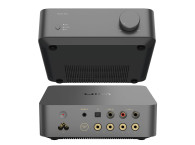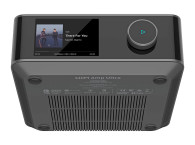Readers of audiopXpress' July 2023 issue may have seen my review of Linkplay Technology’s WiiM Pro, where I gushed about how the "low cost and feature packed" WiiM Pro "...is an excellent way to either unify existing systems and smart speakers around your home or repurpose an old AVR, receiver or integrated amp plus speaker pair you probably have gathering dust.” Never one to sit on their hands, this year the folks at Linkplay have gone one step further by including a power amplifier. Voilà, the WiiM Amp was born.
The WiiM Amp takes all the goodness of a WiiM Pro and brings the Texas Instruments (TI) TPA3255 low-noise Class-D chip amplifier to the party in a footprint slightly smaller than a Mac mini (Photo 1). This allows the WiiM Amp to deliver a hefty 120W/60W of stereo power into a 4Ω or 8Ω load, way more than most consumers would ever need. With a published 90% efficiency, that “Ultra-HD” chip can happily live in a small, heatsink-free 7.5”×7.5”×2.5” package weighing slightly more than 4 pounds (Photo 2).



Additional Features
The line input is always digitized. According to Steven Willenborg, V.P. of Sales at Linkplay, it “...facilitates functions like broadcasting or synchronized playing to multiple rooms, DSP (digital signal processing) functions such as EQ, and output to digital ports if selected.” Good quality five-way binding posts provide a hookup for the speaker of your choice. For wireless connectivity, there’s IEEE 802.11 b/g/n/AC dual-band WiFi, and Bluetooth 5.1 as a source or sink. All common streaming protocols are supported as is a USB 2 mass storage device for your lossy (MP3, AAC, APE, OGG) or HRA lossless (FLAC, ALAC, AIFF, WAV) music library. For satellite/sub speaker setups, there’s even an unbalanced monaural subwoofer out with variable crossover.
The sub channel is converted to analog via TI’s PCM5121, while the line-in is digitized with a PCM1861 monolithic ADC. The two main channels feeding the TPA3255 are derived from an I2S input to ESS’ Sabre ES9018 eight-channel DAC configured for stereo. The gang boss at the heart of the WiiM Amp is Linkplay’s own Amlogic A113X-based A98G module, which handles digital audio I/O, along with wireless streams, user control and visual status feedback (Figure 1).

The Amp Setup
From the user’s point of view, control is via either the included substantial remote or a cross-platform app. For the richest experience, the WiiM Home app is your ticket to myriad musical diversions. When I first received a review unit, I set up my elderly but serviceable Bowers & Wilkins 685 stand-mounted two-ways and IsoAcoustics ISOL8R155 isolation footers on Sanus Foundations Steel stands.
To complete the circuit, I pressed into service an ancient pair of speaker cables* with bananas at both ends. The speakers flanked my office desk, in the near field about 3’ away with the tweeters at ear height. Since I spend most of my day in the office, I decided to try running the iOS version of the app on macOS 14.4.1. It worked like a charm and allowed me to drive things around via either my clicky keyboard and ergonomic mouse or the included remote.
At each stage of the connect/update/configuration process, I was guided to a successful completion. Since the UI has been localized for eight languages, most folks will find the product as easy to use as I did. The geek in me appreciated not only a link in the app to the online user manual and release notes, but also a development roadmap and link to WiiM’s user forum.
During the review period, Linkplay released a macOS beta build, so I looked into that. Unfortunately, it was Intel-only and, since I don’t have Rosetta 2 installed, Apple’s Intel emulation, I stuck with the iOS version. Linkplay’s development team seems to run short sprints, cranking out new features and fixes seemingly monthly, so I wouldn’t be surprised to see a Universal Binary 2 version shortly. A recent update adds Roon Ready certification from Roon Labs. In a press release, Linkplay CEO Lifeng Zhao, opined that the “...WiiM Amp is designed to elevate and unify users’ audio systems, and with the Roon Ready certification, the sound quality and system versatility reach new heights.” For those already in Roon’s ecosystem, this adds yet more value, although an annual Roon subscription costs the same as WiiM Amp itself!
The WiiM App
The app’s Device page is used to show all WiiM devices on the same network (Photo 4). A link/chain feature enables synchronized multi-room playing. You can use one WiiM as the master, playing from a streaming service or local source, and broadcast to all other WiiMs on the same network. One feature the Linkplay user community had asked for in the WiiM Pro was a parametric equalizer along with the existing graphic EQ (Photo 5). The current app has both, making targeted correction and compensation easier. As I usually do, using the four sections I dialed in a gentle 2.2dB at a Q of 0.5 shelving boost at 50Hz to compensate for my speaker’s low-frequency rolloff, with a subsonic -12dB shelf with a Q of 3.05 high pass at 10Hz for protection. I also added a 3.2dB high-frequency shelf with a Q of 0.45 at 13.32kHz for a touch of added presence... easy peasy. The equalization helped reduce stridency and thinness. With my compensation in place, I began to enjoy what amounted to giant headphones while I was at my computer.


Observations
As to my user experience, I cannot overemphasize how well this product is thought through. When I first set up the WiiM Amp, I was pleasantly and literally surprised to hear a voice prompt on first power up. The unit itself said, “Now in setup mode. Follow the devices in your companion app.”
Also, during setup, the app has a FAQ and Feedback link right up front. In my e-mail communications, Willenborg mentioned “As most ‘smart’ devices do these days, a lot of the communication between the phone and the WiiM devices is mediated by the cloud.” Automatic updates are one example (Photo 6 and Photo 7).


Wireless loudspeakers usually rely on a lossy audio stream, and ones large enough to provide any substantive low end are well outside an entry-level price point. Plus, when you purchase your own choice of speaker, you can grab the house sound that makes you happiest.
When looking for the best overall fidelity and value, the WiiM Amp can also be paired with a used speaker pair as I did, opening up a world of endless choices and sonic signatures. As a skewed point of reference, I compared my benchmark component electronics rig with the WiiM Amp driving a set of Qln Prestige One stand mounters that, thanks to James DaRosa at Choice Audio, I had in-house for a review elsewhere.
The WiiM Amp was pitted against my reference DAC and power amp, an exaSound e22 Mk. II and Parasound JC 5. Cabling was courtesy of Rob Fritz at Audio Art Cable. So, how did the small and very affordable WiiM Amp hold up against $10,000 worth of separates?** Quite nicely, thank you! We’re talking oodles of plain ol’ entertainment fun. If one did not have a point of comparison, you would have to be a trained listener to discern the differences between the WiiM Amp and any electronics more costly and of higher performance. As it was, I heard less definition and air, with a diminished soundstage. That said, “less” does not mean granular, sterile, or closed in.
The WiiM Amp brought a solid low end balanced against good midrange subtlety and high-frequency detail. I have had review examples of current production Class-D “audiophile” monoblocks, costing well over $7000 each, that couldn’t hold a candle to this little box. The most obvious lesson I took away from juxtaposing modest with elaborate was just how well the WiiM Amp got out of the way and pulled me into my music (Photo 8).

Conclusions
The multi-award winning WiiM Amp is a modern example of what we used to call a “receiver.” Although I listen to broadcast FM radio every morning, the WiiM Amp sidesteps the lack of a tuner with the inclusion of “Internet radio” capabilities. In short, everything one might need to enjoy audio entertainment is in this cool running appliance with half the footprint of an old-fashioned receiver (Photo 9). It’s a capable and full-featured little marvel that brings a welcome level of refinement to what is normally a disappointing group of shoddily built and poorly documented gear.

Yes, there are several audiophile power streamers out there, for anywhere from double the cost to 10 times that, but the thoughtful engineering, engaging sound quality, and superior user experience are a breath of fresh air in this crowded category. If it’s physical knobs and switches you require, then look elsewhere.
However, if what you need is satisfying sound with all the bells and whistles, controllable from your arm chair, try Linkplay’s entry (Photo 10). I’m sure you will be smugly smiling the first time you cue up your favorite track. aX

Side Notes
* The cables were fabricated from glorified zip cord; “Monster XP Compact Precision Stranded High Resolution Speaker Cable with Magnetic Flux Tube and LPE Dielectric”. That branding is printed repeatedly on the jacketing ...gotta love Noel Lee for his insight, chutzpah, and marketing savvy!
** Rob Fritz provided me with a complete loom, again for review elsewhere, including an 8’ set of his $1690 Statement eSC cryo-treated Ohno Continuous Cast (OCC) speaker cables with Furutech locking bananas. As to the electronics: the exaSound e22 Mk II retailed for $3499 and the Parasound JC 5, currently in production, lists for $6749. The Qln Prestige Ones are $6800, while the matching stands are $850.
This article was originally published in audioXpress, July 2024







